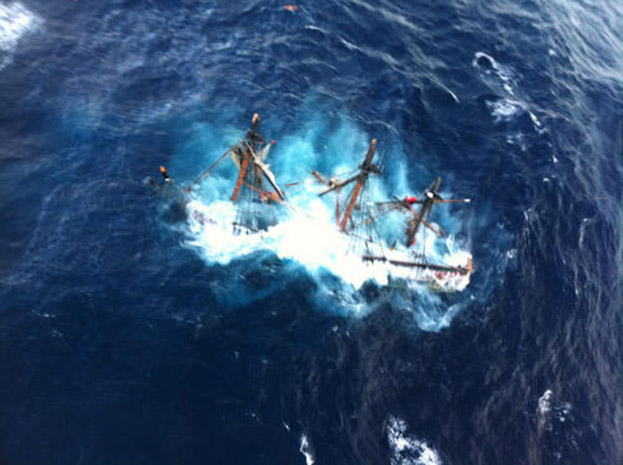An investigation into the 2012 sinking of the HMS Bounty, during Hurricane Sandy, puts the blame on the owners’ management of the vessel and captain’s decisions as contributing factors for the ship going down.

One member of the 16-person crew died when the 33-metre tall ship, built in Nova Scotia in 1960, capsized in high seas and strong winds 197 kilometres off North Carolina on Oct. 29, 2012. The ship’s captain, 63-year-old Robin Walbridge, was lost at sea and is presumed dead.
READ MORE: Survivors break silence about sinking of HMS Bounty in U.S. TV interview (Nov. 2012)
The U.S. Coast Guard (USCG) launched an investigation into the sinking and conducted an inquiry into the sinking that largely focused on Walbridge’s decision to sail into the storm with an “inexperienced crew” on board.
“The findings in the report conclude that a combination of faulty management and crew risk assessment procedures contributed to the sinking,” USCG said in its 93-page report released late Thursday afternoon. Specifically, choosing to navigate a vessel in insufficient condition in close proximity to an approaching hurricane with an inexperienced crew was highlighted.
Read the full report below
- Honda expected to announce Ontario EV battery plant, part of a $15B investment
- Trudeau says ‘good luck’ to Saskatchewan premier in carbon price spat
- Canadians more likely to eat food past best-before date. What are the risks?
- Hundreds mourn 16-year-old Halifax homicide victim: ‘The youth are feeling it’
Walbridge’s name was redacted from all but one reference in the report.
The HMS Bounty, built in 1960 at the Smith & Rhuland Shipyard in Lunenburg, N.S., was modeled after the original Bounty and for the 1962 film Mutiny on the Bounty.
The crewmember who lost her life was 42-year-old deckhand Claudene Christian — a descendent of Fletcher Christian, who led the famed mutiny on the original Bounty in 1789. She was found unresponsive in the water 10 hours after the Coast Guard rescued her crewmates.
READ MORE: 2 U.S. Coast Guard members honoured for rescue of HMS Bounty crew
The ship’s owners, HMS Bounty Organization, are facing a lawsuit from Christian’s mother, also named Claudene Christian. The lawsuit alleges the vessel was not seaworthy and should not have set sail.
The Coast Guard also looked at the decision to abandon ship and concluded that while the order came at a “critical moment,” it came far too late.
The USGC report also looked at the condition of the 52-year-old ship, noting how the amount of rot in the wooden hull and other “inadequate materials” all likely contributed to the vessel taking on water in a number of spots, overwhelming the bilge pump.
READ MORE: Decaying HMS Bounty frame not fixed before Sandy sinking, inquiry told (Feb. 2013)
“From late Saturday, October 27 until the time of the near capsizing on October 29, BOUNTY was subjected to immense racking stresses on the hull due to the heavy seas and wind,” USGC reported.
The U.S. National Transportation Safety Board found, in February, Walbridge made a “reckless decision” to sail an aging vessel into such rough conditions, as it sailed from Connecticut to Florida.
READ MORE: HMS Bounty captain made ‘reckless decision’ to sail into Sandy’s path: NTSB
The Coast Guard recommended HMS Bounty Organization “establish organizational parameters based on weather sea state or destination” and establish requirement for the hiring of a professional engineer “in the event they operate a vessel in the future.”
*With files from The Associated Press




Comments